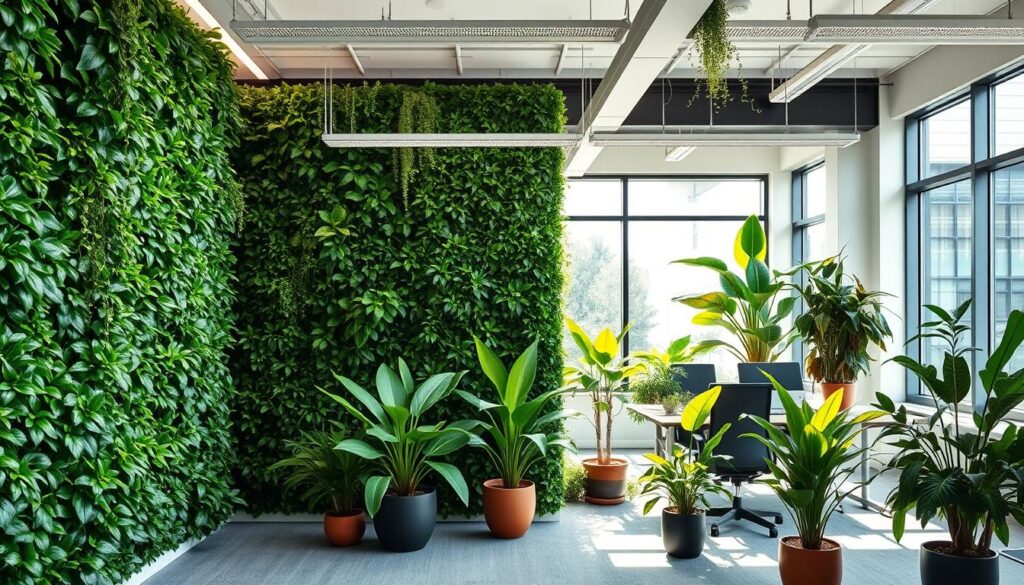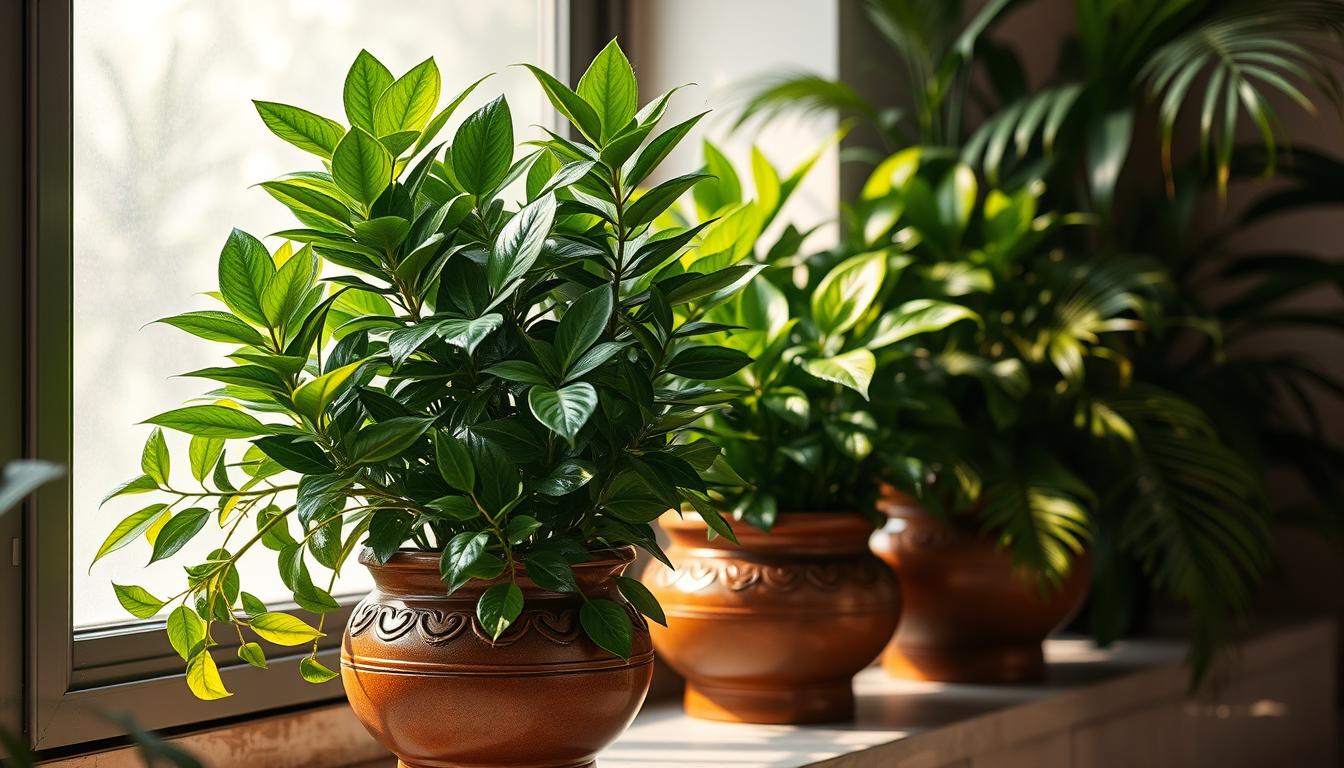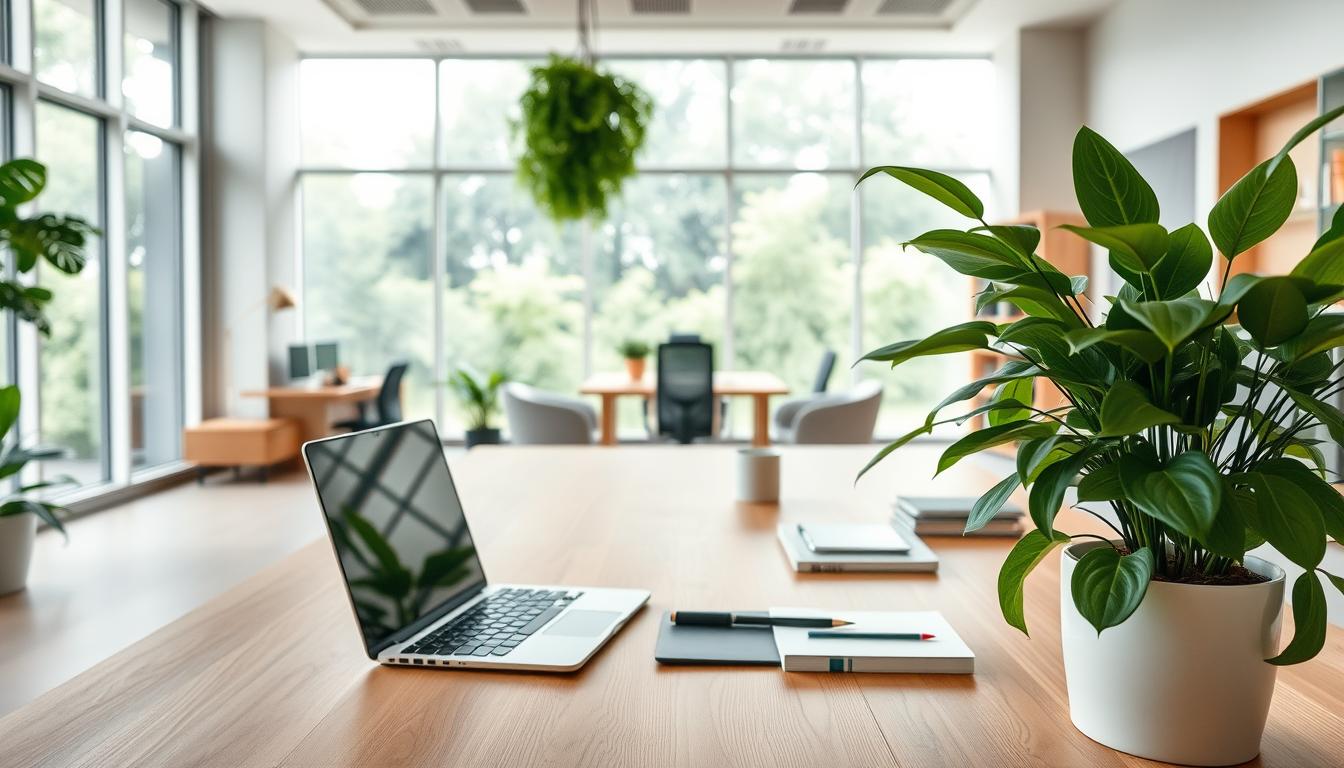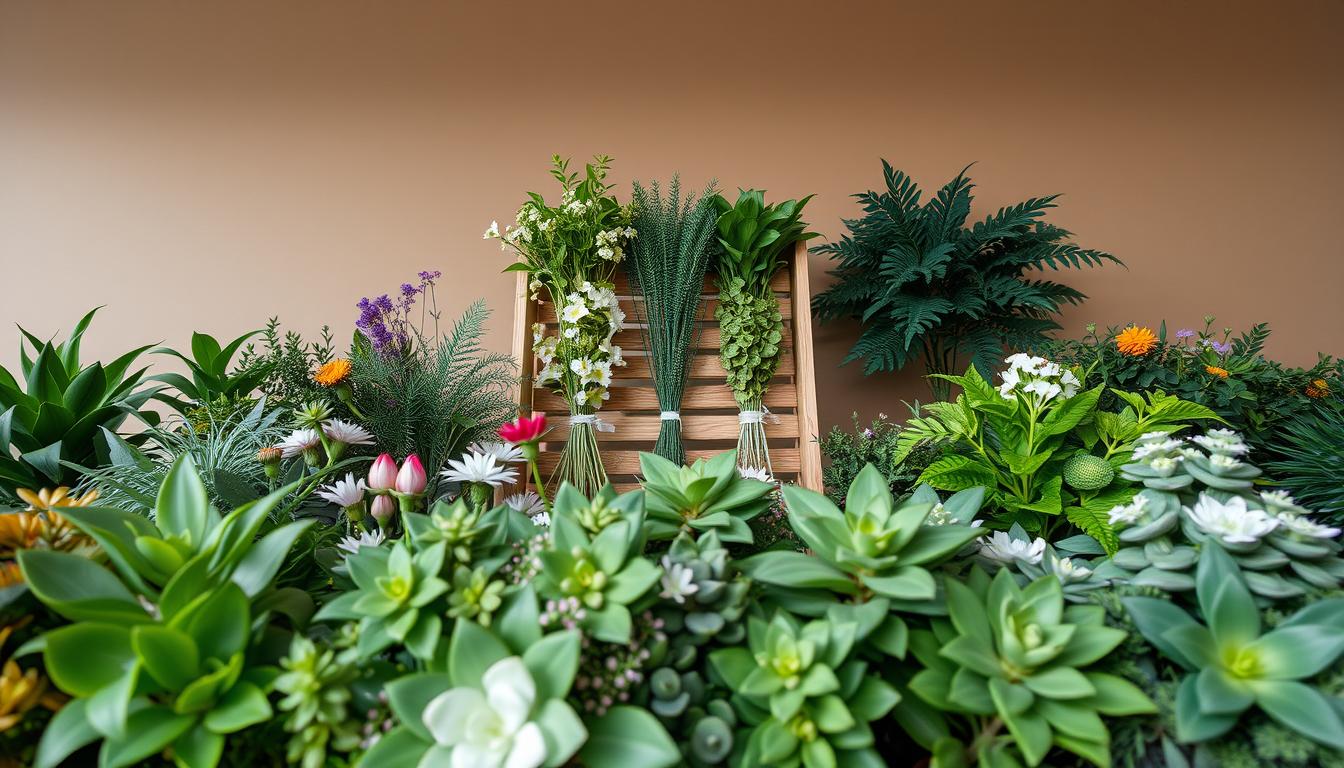Nowadays, adding faux plants to workspaces is crucial for biophilic design. This idea connects people with nature, making the workplace healthier. Unlike real plants, faux plants look like real greenery but don’t need much care. Let’s dive into how to keep these plants looking fresh and lively in your office decor.
The Importance of Biophilic Design in Modern Offices
Biophilic design is key in creating modern offices that boost employee wellness. It makes offices lively by adding nature into them. This includes natural light, plants, and materials from nature, making workspaces healthier and nicer to be in.
Studies show biophilic design has many positives. It can lower stress in employees and make them happier and sharper. For companies wanting the best workers, having a workplace that cares about wellness is important.

Understanding Faux Plants in Biophilic Design
Faux plants, also known as artificial greenery, are great for office design. They bring vibrant colors and make spaces feel closer to nature. Plus, they don’t need a lot of light or care, which is perfect for busy offices.
However, there’s a downside to these plants. They’re often made from materials like PVC. These aren’t great for the planet, which goes against the idea of connecting with nature. Even though they look good, we need to think about their impact on the environment.
So, it’s important to find a balance. We can enjoy the perks of faux plants but should also think about our planet. Understanding how to use them without harming nature is key. This way, we can enjoy their beauty and stay true to eco-friendly values.
Faux Plant Maintenance for Biophilic Office Design
Adding faux plants to office spaces is clever. It mixes beauty with ease. These plants are easy to care for, perfect for busy offices. Faux plants are flexible, so you can get creative with designs. This boosts the look and feel without real plant troubles. Knowing how to keep faux plants looking good is key for their effect in offices.
The Benefits of Using Faux Plants
Faux plants are great because they’re easy to keep. They don’t need water, sunlight, or certain conditions to stay alive. They fit well in many office spots. Plus, there’s no worry about allergies or bugs that real plants might bring. Using fake plants makes offices look better without harming air quality or adding extra work.
Common Faux Plant Maintenance Practices
It’s easy to take care of faux plants, but still important. Dusting often keeps them bright. Here’s how to care for them:
- Dust faux plants every week to keep them clean
- Wash with gentle soap and water sometimes to prevent dirt buildup
- Check for damage or color loss and fix it fast
By doing these easy tasks, faux plants will keep making the office nicer. This helps workers feel better and the office look its best.
Choosing the Right Faux Plants for Your Office
Adding faux plants to your office can make it look better. There are many kinds to pick from. This lets businesses find the best match for different spots in the office. Choosing the right faux greenery makes the office look more unified and beautiful.
Types of Faux Plants to Consider
- Succulents: Ideal for desks and small spaces, they provide a modern touch.
- Hanging Plants: Perfect for vertical spaces, they add greenery without taking up floor space.
- Large Statement Trees: Great for lobbies or spacious areas, these evoke a sense of nature.
- Herbs and Small Bushes: Excellent for kitchen areas or break rooms, adding a welcoming vibe.
How to Select Quality Faux Greenery
It’s important to choose good quality fake plants to make them look real. Here are some tips:
- Realism: Look for plants with detailed textures and natural colors to avoid a cheap appearance.
- Material: Opt for durable materials that withstand the test of time to maintain visual appeal.
- Maintenance: Choose designs requiring minimal upkeep, allowing for a worry-free environment.
- Compatibility: Ensure the selected faux plants complement existing decor, enhancing the overall ambiance.
Creating a Harmonious Office Space with Faux Plants
Faux plants help make offices more harmonious and improve the work environment. Putting fake plants in places everyone sees, like empty spots or sunny areas, helps workers feel better and more creative. These plants make the office look good and help people work together better.
Adding fake greenery makes the workplace more positive and welcoming. The right faux plants can make a dull office lively and exciting. Using fake plants carefully can make the office feel more natural and balanced.
Key Faux Plant Maintenance Tips
Keeping faux plants looking great is key to a nice office space. The right care can make them look real and inviting. Here are easy tips to keep your faux plants in top shape.
Dusting and Cleaning Faux Plants
It’s important to dust and clean faux plants often. Dust can make them look dull. Follow these steps:
- Use a soft microfiber cloth to gently wipe leaves and stems.
- For stubborn dirt, mild soap mixed with water can be used, followed by a thorough rinse.
- Keep plants stored away from humidity to reduce grime accumulation.
How to Prevent Color Fading of Faux Plants
To keep your faux plants bright, follow these color saving tips:
- Avoid exposing faux plants to direct sunlight, as this can lead to fading over time.
- Utilize UV-protective sprays designed specifically for faux plants to shield colors from harmful rays.
- Inspect plants periodically for signs of wear and replace them as needed to maintain a vibrant office ambiance.
The Environmental Impact of Faux Plants
Faux plants make offices look nice but have an environmental cost. Their production and throwing away involves a lot of waste and use of resources. This makes people wonder if they are a good choice for the planet.
Longevity vs. Sustainability
Faux plants don’t need to be replaced often, leading to less trash. This is good for places that can’t take care of real plants often. But, the stuff they’re made of, like plastics, hurts the environment. This makes it hard to decide if they are truly green.
Alternative Eco-Friendly Options
There are greener choices available for those wanting to lower their environmental impact. Options like preserved moss or air plants look great and are better for the planet. Using these in office designs makes the space beautiful in a sustainable way. Picking these green options creates a better office and shows care for the planet.
Incorporating Faux Plants Into Your Office Design
Adding faux plants to your office design boosts the look and feel of the space. It makes the office more inviting. Placing these plants smartly can change how the workspace feels and is used. Using faux plants helps create a balanced and beautiful office environment.
Strategic Placement of Faux Plants
Think about putting faux plants in areas where people often go. Important spots include:
- Reception areas, providing a warm welcome to visitors.
- Conference rooms, for a calming atmosphere during meetings.
- Breakout spaces, to encourage relaxation and creativity.
Faux plants can work as natural-looking barriers in an open office. They offer privacy but keep the space looking open. They’re great for dividing areas without blocking light or air.
Mixing Faux Plants with Natural Elements
Combining faux and real plants is a great design move. It creates a peaceful and positive work area. Here are ways to mix them:
- Pairing tall faux plants with small real succulents for varied heights and textures.
- Integrating faux planters within living walls, creating depth and interest.
- Using faux plants alongside natural wood and stone decor for a cohesive natural theme.
This mix of real and faux greenery makes the office look harmonious. It makes the workspace healthier, boosts productivity, and lowers stress.
Addressing Employee Concerns on Faux vs. Real Plants
Employees often worry about how faux plants affect them mentally and regarding health risks. They feel a special connection to real plants and nature. Knowing this can help organizations decide whether to add faux greenery.
Psychological Impacts of Faux Plants
Studies show workers really bond with real plants, making them feel happier. Real plants can make a workplace feel more soothing and increase satisfaction. However, some may see faux plants as not genuine, which could lessen these good feelings. Informing employees about the looks and upkeep benefits of faux plants might change their views.
Health Considerations in Faux Plant Use
It’s important to consider health when looking at faux plants. Some are made from stuff that could release harmful chemicals. Picking high-quality faux plants that are safer can address health worries. Knowing what faux plants are made of helps make choices that are good for health and the office look.
Cost-Effectiveness of Faux Plants for Businesses
Faux plants offer big benefits for businesses that want to cut costs and still look good. They might seem expensive at first. But, when you compare them with the constant care real plants need, faux plants are cheaper in the long run.
Taking care of real plants takes a lot of work and money. They need water, food, and new pots. On the other hand, faux plants are easy. They stay looking fresh without extra help, cutting down on upkeep costs.
- Reduced maintenance costs
- No need for specialized care or watering systems
- Long-lasting aesthetics without deterioration
For companies watching their spending, faux plants are a smart choice. They make workplaces feel welcoming without the ongoing costs of real plants. In today’s tough business world, using affordable greenery can lift employee spirits and increase their productivity. This makes fake plants a great option for many.
Faux Plant Trends in Office Design
Modern workspaces are now featuring faux plants more and more. Businesses want their spaces to feel welcoming and lively. Because faux plants are easy to care for, they’re becoming a top choice for many companies.
The Rising Popularity of Faux Plants
The love for faux plants is growing because they’re so flexible. They can fit into many design themes easily. Offices use them to make the space feel peaceful and look better. This marks a big change, as companies now prefer these plants for both their look and their low environmental impact.
Innovative Uses for Faux Greenery in Workspaces
Companies are getting really creative with faux plants in their areas. Options include:
- Creating stunning living walls that serve as focal points and enhance the overall ambiance.
- Integrating faux plants into artistic displays and sculptures, providing visual interest.
- Using plants to delineate spaces and improve acoustics, contributing to a more functional workspace.
Faux greenery is changing the look and feel of workspaces today. It brings together style and practicality in a unique way.
Conclusion
Faux plant care is key in biophilic design. By using these plants, places look better and improve employee wellbeing. Choosing and keeping faux plants right helps businesses make spaces that look good and work well.
Biophilic design means mixing nature’s beauty with office needs. Knowing how to use fake plants well helps companies choose wisely. This way, they stick to biophilic ideas and care about sustainability.
As offices change, faux plants become very important in design. They add beauty and think of the environment. This helps make offices that are not only nice to look at but also good for health and lively.



